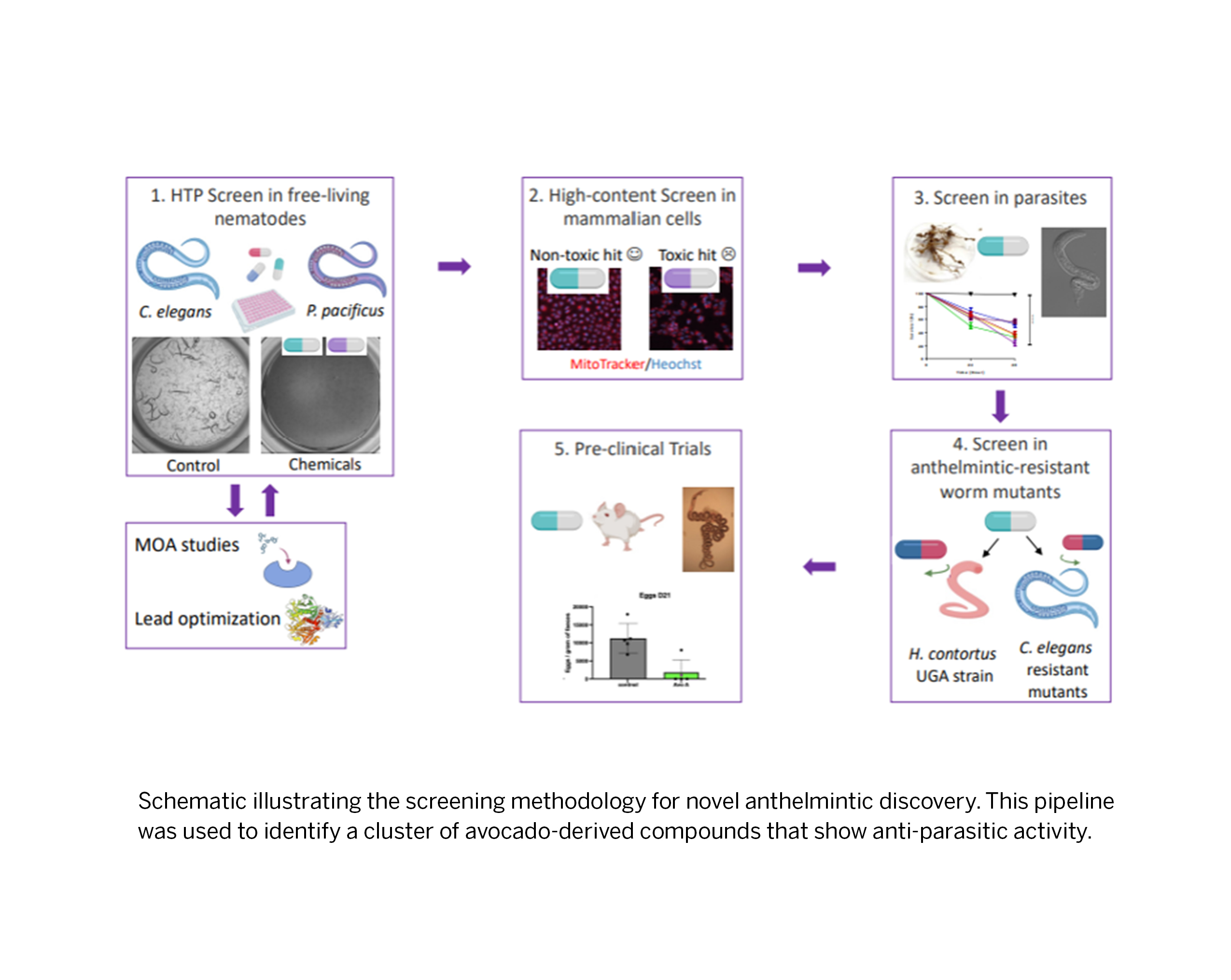Novel Class of Anthelmintic Compounds and Proprietary Screening Method for Anthelmintic Discovery
Novel anthelmintics with differentiated mechanisms of actions and therapeutic efficacy across multiple developmental stages

Technology
The Gunsalus and Piano Lab have identified four natural compounds derived from the avocado Persea americana that show potent anthelmintic effects on human and animal parasites. As described in unpublished work, their team tested a commercially available ~2,000 compound small-molecule library using a proprietary screening method against two distantly related nematodes (C. elegans and P. pacificus) for initial hit identification. This step was followed by a counter-screen for mammalian cell toxicity and dose-response efficacy testing of the remaining hit candidates across different developmental stages of C. elegans (see schematic). The hit compounds, collectively termed “Avo compounds”, are structurally related 17-carbon fatty acid alcohols and acetate variants that elicit lethality in parasites across all life stages, including impairing egg hatching in the parasitic nematode species P. pacificus, H. contortus, T. circumcincta, H. polygyrus, and others. Importantly, these compounds did not show toxicity in human cells (U2-OS cell line) at compound concentrations 5-fold greater than the parasitic lethal dose. In mechanistic studies, the Avo compounds were found to cause rapid dose-dependent paralysis and death in worms (within 5 mins.) by interfering with fatty acid metabolism, a novel mechanism of action for anti-parasitic drugs. Not surprisingly, these compounds showed efficacy against mutant strains of C. elegans that are resistant to common anthelmintics (ivermectin/abamectin, albendazole, levamisole, etc.) and to a multidrug resistant UGA strain of the parasite H. contortus. In animal studies using mice infected with H. polygyrus, Avocatin A (an Avo compound) was found to significantly reduce the fecal egg count and adult worm load. This cluster of identified Avo compounds represents promising early-stage therapeutic candidates for a differentiated class of anthelmintics with broad neutralizing capabilities across species and developmental life stages.
Background
Parasitic helminths (roundworms, flukes, tapeworms, etc.) are a major global threat to human health, infecting more than 1.5 billion people in primarily low- and middle-income countries. Helminth infections also have a devastating impact on livestock and agricultural production globally, causing huge economic losses of over approximately $80 billion per year. Helminth infections are particularly challenging to treat without causing off-target toxicity to mammalian hosts due to strong physiological similarities and a multitude of resistance mechanisms to block drug uptake and drug metabolism, especially in the larvae stage. Additionally, nematodes have thick protective outer layers that afford protection against harsh conditions and provide resistance to therapeutic agents. Despite the global burden caused by helminths, only a few drugs are commonly used to treat human and livestock infections (e.g., ivermectin and albendazole) and rising drug resistance is complicating control efforts. Thus, new chemical classes of anthelmintics with novel mechanisms of action are urgently needed to diversify our therapeutic armamentarium and combat drug-resistant strains. Relatedly, there is an accompanying unmet need for innovative screening methodology to identify such compounds that show efficacy across parasitic developmental stages and against multiple distantly-related species.
Applications
- Treatment of infections from parasites
- In humans; including tapeworms, hookworms, and liver flukes
- In livestock; including gastrointestinal nematodes
- In crops; including root-knot nematodes, cyst nematodes, root lesion nematodes, and burrowing nematodes
- In companion and domesticated animals; including roundworms, heartworms, lungworms, hookworms, and intestinal nematodes
Advantages
- Differentiated mechanism of action: Avo compounds target fatty acid metabolism in parasites
- No off-target toxicity: mammalian cells were not killed by Avo anthelmintics
- Superior efficacy over standard-of-care anthelmintics in killing parasitic eggs
- Neutralization of parasites across developmental stages: Avo compounds show efficacy during egg hatching, larval development, and adult survival
- Effective against multi-drug resistant parasites: Able to neutralize a H. contortus multi-drug resistant strain resistant to ivermectin/abamectin, albendazole, and other standard anthelmintics
- Mono- or combination therapy: Avo compounds be used independently and/or in combination with known anthelmintics
Development Status
Lead anthelmintic Avo compounds are currently being tested for in vivo efficacy in helminth-infected mice.
Intellectual Property
A U.S. provisional patent application has been filed covering the composition of the anthelmintics, their methods of use, and the screening methodology used to discover them.
-
expand_more mode_edit Authors (2)Fabio Piano, PhDKristin Gunsalus, PhD
-
expand_more cloud_download Supporting documents (2)Product brochureNovel Class of Anthelmintic Compounds and Proprietary Screening Method for Anthelmintic Discovery.pdfMarketing BriefNYU - Anthelmintic Compounds for Anthelmintic Discovery - Marketing Brief- PIA01-02.pdf (127 KB)